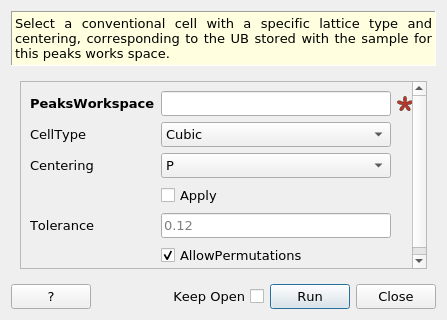\(\renewcommand\AA{\unicode{x212B}}\)
SelectCellOfType v1¶

SelectCellOfType dialog.¶
Summary¶
Select a conventional cell with a specific lattice type and centering, corresponding to the UB stored with the sample for this peaks works space.
See Also¶
FindUBUsingFFT, FindUBUsingIndexedPeaks, FindUBUsingLatticeParameters
Properties¶
Name |
Direction |
Type |
Default |
Description |
|---|---|---|---|---|
PeaksWorkspace |
InOut |
IPeaksWorkspace |
Mandatory |
Input Peaks Workspace |
CellType |
Input |
string |
Cubic |
The conventional cell type to use. Allowed values: [‘Cubic’, ‘Hexagonal’, ‘Rhombohedral’, ‘Tetragonal’, ‘Orthorhombic’, ‘Monoclinic’, ‘Triclinic’] |
Centering |
Input |
string |
P |
The centering for the conventional cell. Allowed values: [‘F’, ‘I’, ‘C’, ‘P’, ‘R’] |
Apply |
Input |
boolean |
False |
Update UB and re-index the peaks |
Tolerance |
Input |
number |
0.12 |
Indexing Tolerance |
NumIndexed |
Output |
number |
The number of indexed peaks if apply==true. |
|
AverageError |
Output |
number |
The average HKL indexing error if apply==true. |
|
AllowPermutations |
Input |
boolean |
True |
Allow permutations of conventional cells |
TransformationMatrix |
Output |
dbl list |
The transformation matrix |
Description¶
Given a PeaksWorkspace with a UB matrix corresponding to a Niggli reduced cell, this algorithm will allow the user to select a conventional cell with a specified cell type and centering. If the apply flag is not set, the information about the selected cell will just be displayed. If the apply flag is set, the UB matrix associated with the sample in the PeaksWorkspace will be updated to a UB matrix corresponding to the selected cell AND the peaks will be re-indexed using the new UB matrix. The output transformation matrix \(M\) will change \(UB\) to \(UBM^{-1}\) and map each \((HKL)\) vector to \(M(HKL)\). It can be further used by the TransformHKL algorithm. NOTE: The possible conventional cells, together with the corresponding errors in the cell scalars can be seen by running the ShowPossibleCells algorithm, provided the stored UB matrix corresponds to a Niggli reduced cell.
This algorithm is based on the paper: Alan D. Mighell, Lattice Symmetry and Identification—The Fundamental Role of Reduced Cells in Materials Characterization. Journal of research of the National Institute of Standards and Technology 106.6 (2001): 983, available from: nvlpubs.
Usage¶
Example:
ws=LoadIsawPeaks("TOPAZ_3007.peaks")
FindUBUsingFFT(ws,MinD=8.0,MaxD=13.0)
print("Lattice before SelectCellOfType:")
lattice = ws.sample().getOrientedLattice()
print(" ".join("{:.9f}".format(x) for x in [lattice.a(), lattice.b(), lattice.c(),
lattice.alpha(), lattice.beta(), lattice.gamma()]))
SelectCellOfType(PeaksWorkspace=ws, CellType='Monoclinic', Centering='C', Apply=True)
print("\nLattice after SelectCellOfType:")
lattice = ws.sample().getOrientedLattice()
print(" ".join("{:.9f}".format(x) for x in [lattice.a(), lattice.b(), lattice.c(),
lattice.alpha(), lattice.beta(), lattice.gamma()]))
Output:
Lattice before SelectCellOfType:
8.605818643 11.935925461 11.941812766 107.429088323 98.752912466 98.951193475
Lattice after SelectCellOfType:
14.131051152 19.247332564 8.605818643 89.881170675 105.071333770 89.970386662
Categories: AlgorithmIndex | Crystal\Cell
Source¶
C++ header: SelectCellOfType.h
C++ source: SelectCellOfType.cpp
